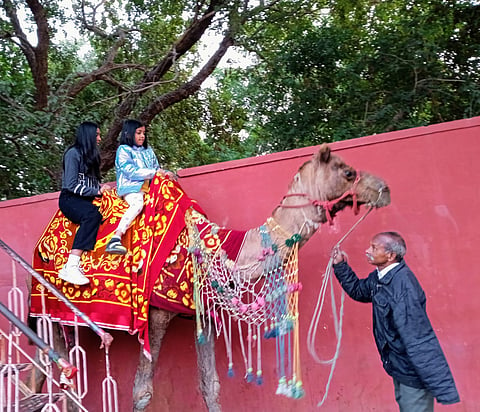
- Destinations
- Experiences
- Stay
- What's new
- Celebrating People
- Responsible Tourism
- CampaignsCampaigns
- SubscribeSubscribe
- Buy Now

The centuries-old walled city of Jaipur lives up to its reputation as a planned metropolis for the most part its enchanting bazaars, forts, and buildings bear their heritage with pride its perfectly laid-out streets are easily navigated and the uniform pink hue of the ancient city walls as well as the grand, regal monuments evoke a flamboyant past. The monuments here are the obvious draw, but lately, the focus is on niche experiences that focus on the Pink City's many shades. If you are travelling with children, Jaipur can be a treasure trove. From having your photo taken with a 160-year-old "memory box" camera and getting up close and personal with a 2,300-year-old Egyptian mummy to adventures on a hot air balloon, staying in a treehouse, and watching a film at one of India's grandest cinemas, here's how to make your trip to Jaipur memorable for kids.
When you find yourself near Hawa Mahal, look out for Tikam Chand, who takes pictures with a century-old box camera that dates back to the 1860s. It produces the most amazing black and white photographs. In his family for three generations, the camera has been patched and repaired more than hundred times. The materials needed to develop photos is imported from France.
Phone: +91 90247 15885
The photos are available in two sizes, priced at INR 500 and INR 1,000, respectively.
Taking in a matinee show at this gorgeous blast-from-the-past cinema hall that dates back to the 1960s Gem Cinema has hosted some of the biggest stars of Indian celluloid, but the arrival of the multiplex culture led to it shutting down in 2005. However, after a restoration drive, it has reopened. Spend money on a ticket to immerse yourself in this charming space that looks like it came straight out of a Wes Anderson film. While there, let your kids take in the Art Deco architecture with its geometric gem-like pink and white exterior that looks like cake icing.
This unique gems and jewellery museum is much more than just a museum. Set up in a 100-year-old heritage haveli, with Aravali Hills in the backdrop, Khazana Mahal is a must-visit, particularly if you have kids in tow. From gaining a first-hand experience in pottery to trying out the zipline, it is a wonderfully enriching experience for kids.
For more information, click here.
The Albert Hall Museum, now called the Central Government Museum, is located in Ram Niwas Bagh, a public garden built in 1868 by Sawai Ram Singh II and modelled on the Victoria and Albert Museum in London. The building was designed by Sir Swinton Jacob in the Indo-Saracenic style. The vast collection of exhibits at the facility includes metalware, jewellery, pottery, textiles, and other antiquities. Do look out for the Egyptian mummy and a rare collection of coins from the Gupta, Kushan, Delhi Sultanate, Mughal, and British eras.
For more information, click here.
Nestled quietly in the lap of the Aravalli Hills lies the Jhalana Leopard Reserve. Just 10 km from the heart of Jaipur, it is the city's best-kept secret and finds its way onto the itineraries of only the most avid wildlife enthusiasts, often shadowed by the more popular Ranthambore National Park. With an area of 23 sq km, Jhalana is said to be the world's most densely populated leopard reserve. Divided into three zones, each with a different topography, Jhalana is a delight for anyone interested in nature.
For more information, click here.
You have heard of heritage walks, but how about a heritage water walk This is an especially topical thing to do, considering the urgent need to conserve our water resources across the planet. Jaipur-based Neeraj Doshi, who has spent a decade and a half working in the sustainability space, started Heritage Water Walks to showcase a cultural phenomenon of the desert state of Rajasthan.
Neeraj Doshi, founder of Heritage Water Walks and a graduate of Boston's Tufts University's Fletcher School of Law and Diplomacy, delves deep into his roots of the village ways to reveal their deeply embedded water conservation practices that are as relevant to the desert state today as they were centuries ago. He has spent a decade and a half working in the sustainability space and started Heritage Water Walks to showcase this lesser-known cultural phenomenon of Rajasthan.
It's not everyday that we get to ride a camel. So when in Jaipur, kids can have a unique experience riding a camel. Camels can be easily spotted near Jal Mahal. A 10-minute ride costs about INR 150 per person. Two kids can be accommodated at one time, which amounts to INR 300.
